Philosophy of Wine
A SMALL KRUŠEDOL MANUAL ABOUT RIESLING AND BERMET
A Wine Treat
I can tell you all this, my friend, you can even write it down, but if you don’t feel it within yourself, if you cannot hear wine, you cannot make it good. Good wine is not made, it’s deserved. The winemaker makes wine, but it’s also the other way round. Archimandrite Damaskin left us a discussion about the Riesling called amber. The thing is in the mixture: the less virtue among people, the worse the mixture. Zaharije Orfelin talks about bermet, a beverage only for the noble ones. Listen to his winter and summer recipe
By: Marina Gorski
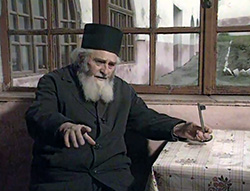 The donation of nice words and good morals of the passed away Archimandrite Damaskin, from Krušedol monastery, deserves a great and worthy place.
The donation of nice words and good morals of the passed away Archimandrite Damaskin, from Krušedol monastery, deserves a great and worthy place.
”In the past, the tastiest wine was red wine, and after World War I, grape varieties for making white wine were grown. People started drinking spritzer, you know, wine mixed with soda, so there were several types of white wine produced. The first class was Riesling, the Italian one, called amber. Afterwards there were other Rieslings, such as Banate, but it was far behind the Italian one in quality. Private winegrowers in Fruška Gora cultivated grape varieties for making wine, but those that yield much wine. The Italian Riesling yielded less, only it was of very high quality, so it was mixed with grape varieties that yielded much liquid. We, in monasteries, took care to produce Riesling as pure as possible, without too many supplements. However, I did hear from our capable winegrowers, that Riesling could not be pure. It is of very high quality, has a high percentage of sugar and necessary aroma, but it must always be mixed with another grape variety that gives more liquid. They made proportions in order to increase their commercial activities. (...)
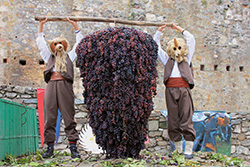 When wine is decanted, the barrels must be washed. So, as a young man, before I entered the monastic order, I had the luck and honor to wash barrels, of course also to drink wine, although it would have been better if I didn’t. I drank it a bit too much, it was bad for my health.”
When wine is decanted, the barrels must be washed. So, as a young man, before I entered the monastic order, I had the luck and honor to wash barrels, of course also to drink wine, although it would have been better if I didn’t. I drank it a bit too much, it was bad for my health.”
Thus spoke Archimandrite Damaskin. Zaharija Stefanović Orfelin taught and wrote in his book Experienced Cellarman how to make real wine, bitter wine or absinth wine with grapes, and bermet. How to make, from different herbs and their roots and different grape varieties, wines that improve health and protect from different diseases. Those wines, as we said, are not used for cheerfulness, but for improving the state of the body in case of internal and external diseases. Thus it would be good if those with bigger vineyards could make at least a little of such wine, to be able to help both themselves and their friends in need – advises Orfelin.
BERMET IS WHERE ABUNDANCE IS
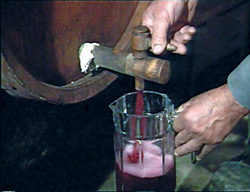 He continues in detail about the perhaps most famous wine of Karlovci:
He continues in detail about the perhaps most famous wine of Karlovci:
”There is bermet made artificially, industrially, and there is the natural one, which can be found in monasteries or some large estates with large vineyards and lots of wine. Bermet cannot be produced by just anyone. Those with little vineyards, who must eat grapes, sell grapes, squeeze some wine out of them, cannot make bermet. What will he make it from?
Bermet is a luxurious and very refined beverage. This wine was used in rich houses, big estates and monasteries. It was like a wine treat. It was something that one does not drink much. During a banquet, people drink all kinds of wine. Some like red, some rose, some Riesling, some black. There are people who drink only black wine. Then, when they drink enough of everything, they treat themselves with a bit of bermet. Bermet is not consumed throughout the year. Only in winter. Only a large estate with a large vineyard and great variety of grapes could produce bermet.
 It’s simple, not some unattainable recipe. Only three main elements are important:
It’s simple, not some unattainable recipe. Only three main elements are important:
The barrel must be absolutely healthy and clean, not more than 100 liters… Then, the grapes must be chosen and selected. During the grape harvest, the grapes are selected, only healthy, plump and good ripe ones are put aside, and not of all varieties. Bermet was mostly made from Portugieser, a variety of red grapes which ripens at the time summer is still in its climax and the grapes full of sun, to produce the necessary quantity of sugar in it. So, Portugieser. Then, the third main element is fine white wine, with a sufficient percentage. When you make the basis of red grapes and add white wine, you get a ruby red bermet. It’s not too dark, just nice and red.”
FEELING THE REAL TASTE
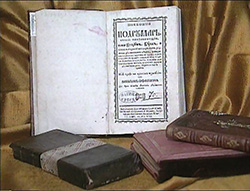 Now, there are also other conditions to be met to have a successful bermet – continues Zaharija Orfelin.
Now, there are also other conditions to be met to have a successful bermet – continues Zaharija Orfelin.
”At the time of the grape harvest, while the sun is still high, on a nice day, at the beginning of September, two clusters of grapes are tied on a ribbon, on a thicker rope, and then again another two clusters. If they are smaller, could also be three. Such selected clusters are tied on the rope and piled. In the meantime, hooks made of knotty wood, such as oak, are cut in the forest, about a meter long. The clusters are then laid on those hooks, ten to twenty kilograms. Then the hooks are hung somewhere where there is a draught, but under weeds, in a shade. There are hallways in monasteries, you know, through which no one passes. The grapes are dried until the beginning of December, until the Day of Presentation of Mary. It must wither a bit. When the day comes, the withered grapes are taken from the hooks and put onto a table, and then laid in the barrel. Now, this is something very important.
The barrel must be opened. There must be a skilled artisan, a barrel maker, who will do it professionally, so as not to damage the barrel. Then the grapes are laid into the barrel. The first layer, a ”tavan” as they call it, is made of grapes, about the width of a palm. You buy mustard seed in the shop, take a handful and spread it over the grapes. You also buy in the shop some dried figs, high quality and nice, and put several inside. Then you clean well a few belts of horseradish and cut them, so you know, 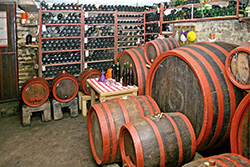 you put a few inside. There used to be yellow sugar in large pieces; a bit of it should also be put in the first layer. You buy in the shop small nuts, take one or two, cut them into small pieces and put them as well. During the summer, you pick some absinthe flowers: you cut them while they are in blossom, to the ground. There is a bit of leaves and a bit of flowers, and they should be dried. So this absinthe is also cut into small pieces and put into the first layer. And that’s the first layer. Then again come the grapes, then everything I already said, then again grapes, then again everything bought in the shop, until you reach the top of the barrel. Then the barrel maker, who should be there, closes the barrel.
you put a few inside. There used to be yellow sugar in large pieces; a bit of it should also be put in the first layer. You buy in the shop small nuts, take one or two, cut them into small pieces and put them as well. During the summer, you pick some absinthe flowers: you cut them while they are in blossom, to the ground. There is a bit of leaves and a bit of flowers, and they should be dried. So this absinthe is also cut into small pieces and put into the first layer. And that’s the first layer. Then again come the grapes, then everything I already said, then again grapes, then again everything bought in the shop, until you reach the top of the barrel. Then the barrel maker, who should be there, closes the barrel.
Then you pour in first-class white wine, at least two years old, it’s also good if it’s three, you know the one that has already breathed, without any scents and without any kind of fungi which could spoil the wine. After pouring the wine, you leave it like that for six weeks. A faucet is put around Christmas and the wine is poured. People drink it in January, for important holidays. It was like that in the monastery. When about half of the barrel is consumed, you stop drinking and the wine is filled into nice, clean bottles. The bottles are sealed with cork stoppers and put somewhere in the cellar, into sand. That is how they are kept for the summertime, when people in rich houses need to drink something special.
Then comes the time to pour new wine into the same barrels. You don’t need to wait for the fermentation of the second bermet. As soon as it is poured in, it can be consumed immediately, after two or three days. That bermet is not like the first one, it is a bit sweeter, a bit nicer, so it is consumed like that: second edition of bermet.
That’s the story about bermet.”
***
Railway
”The monastery of Vrdnik, Ravanica, had many vineyards”, says Archimandrite Damaskin. ”We had a railway, so we could produce large quantities of wine. Thanks to the railway we could transport it further and find more customers.”
***
Busy Throughout the Year
”There is work in the vineyard throughout the year. Even when it’s snowing you have things to do if you want to have a good and proper vineyard”, adds Damaskin. ”Same thing in the cellar. There is always wine to decant because gets some scent. There is also the regular decanting during the year. Older wines should be decanted twice a year and younger wines, up to two years old, should be decanted four times.”
